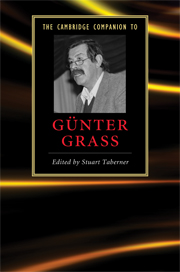Book contents
- Frontmatter
- Introduction
- 1 Biography as politics
- 2 Günter Grass’s political rhetoric
- 3 The exploratory fictions of Günter Grass
- 4 Günter Grass and magical realism
- 5 Günter Grass’s ‘Danzig Quintet’
- 6 Günter Grass and gender
- 7 Authorial construction in From the Diary of a Snail and The Meeting at Telgte
- 8 Günter Grass’s apocalyptic visions
- 9 Günter Grass and German unification
- 10 Günter Grass’s Peeling the Onion
- 11 Günter Grass as poet
- 12 Günter Grass and art
- 13 Günter Grass as dramatist
- 14 Film adaptations of Günter Grass’s prose work
- 15 Günter Grass and his contemporaries in East and West
- Guide to further reading
- Index
5 - Günter Grass’s ‘Danzig Quintet’
Published online by Cambridge University Press: 28 January 2010
- Frontmatter
- Introduction
- 1 Biography as politics
- 2 Günter Grass’s political rhetoric
- 3 The exploratory fictions of Günter Grass
- 4 Günter Grass and magical realism
- 5 Günter Grass’s ‘Danzig Quintet’
- 6 Günter Grass and gender
- 7 Authorial construction in From the Diary of a Snail and The Meeting at Telgte
- 8 Günter Grass’s apocalyptic visions
- 9 Günter Grass and German unification
- 10 Günter Grass’s Peeling the Onion
- 11 Günter Grass as poet
- 12 Günter Grass and art
- 13 Günter Grass as dramatist
- 14 Film adaptations of Günter Grass’s prose work
- 15 Günter Grass and his contemporaries in East and West
- Guide to further reading
- Index
Summary
This chapter explores the interconnections between five of Grass's literary works, extending John Reddick's long-standing and influential notion of the 'Danzig Trilogy', The Tin Drum (1959), Cat and Mouse (1961) and Dog Years (1963), to that of the 'Danzig Quintet', through the inclusion of two later works, Local Anaesthetic (1969) and Crabwalk (2002). The first section of the chapter examines how the quintet is bound together through an extended family network of characters, resulting in a richly interwoven set of texts that moves back and forth between the past and the present, as well as the private and the public spheres of individual memory and history. The second and third sections explore the dual conceptualisation of memory within the texts (as a form of testimony on the one hand, and as a representation open to distortion on the other) in the context of the larger issue of engaging with the National Socialist past, while the final section uses Umberto Eco's notion of an 'inferential walk' to examine how the interactions between the quintet's narratives shapes the reader's relation to the texts. 'The Danzig Quintet' Günter Grass's The Tin Drum, Cat and Mouse, Dog Years, Local Anaesthetic and Crabwalk were written over a period of forty years, with the first of the works appearing in 1959 and the last in 2002.
- Type
- Chapter
- Information
- The Cambridge Companion to Günter Grass , pp. 67 - 80Publisher: Cambridge University PressPrint publication year: 2009

